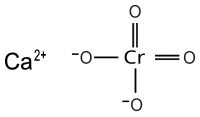Calcium chromate
 Calcium chromate
|
|
 Calcium chromate dihydrate
|
|
| Names | |
|---|---|
|
IUPAC name
Calcium dioxido-dioxo-chromium
|
|
| Other names
Calcium chromate (VI)
Calcium monochromate Calcium Chrome Yellow C. I. Pigment Yellow 33 Gelbin Yellow Ultramarine |
|
| Identifiers | |
|
3D model (Jmol)
|
|
| ChemSpider | |
| ECHA InfoCard | 100.033.955 |
| EC Number | 237-66-8 |
|
PubChem CID
|
|
| RTECS number | GB2750000 |
|
|
|
|
| Properties | |
| CaCrO4 | |
| Molar mass | 156.072 g/mol |
| Appearance | bright yellow powder |
| Density | 3.12 g/cm3 |
| Melting point | 2,710 °C (4,910 °F; 2,980 K) |
|
anhydrous
4.5 g/100 mL (0 °C) 2.25 g/100 mL (20 °C) dihydrate 16.3 g/100mL (20 °C) 18.2 g/100mL (40 °C) |
|
| Solubility | soluble in acid practically insoluble in alcohol |
| Structure | |
| monoclinic | |
| Related compounds | |
|
Other anions
|
calcium dichromate |
|
Other cations
|
Beryllium chromate Magnesium chromate Strontium chromate Barium chromate Radium chromate |
|
Except where otherwise noted, data are given for materials in their standard state (at 25 °C [77 °F], 100 kPa).
|
|
|
|
|
| Infobox references | |
Calcium chromate (CaCrO4) is a bright yellow solid. It normally occurs as the dihydrate.
Calcium chromate loses water at 200 °C. It reacts with organic matter or reducing agents to form chromium(III). The solid will react explosively with hydrazine. If mixed with boron and ignited, calcium chromate will burn violently.
It is used as a pigment, a corrosion inhibitor, and in electroplating, photochemical processing, and industrial waste treatment.
...
Wikipedia
